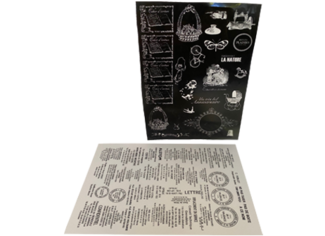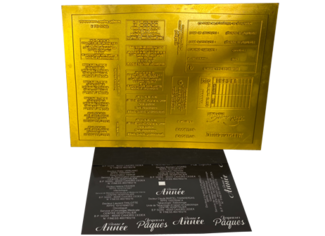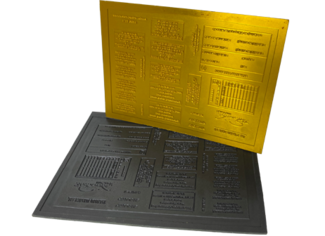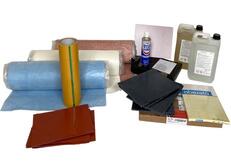Our company origin
Products and equipment for rubber stamp making
Materials and supplies needed
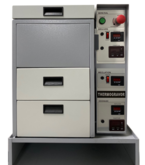
Thermogravor photopolymer processing machine
A 4 size photopolymer processing machine
Designed and manufactured by our company, to produce photopolymer stamps from liquid resin or hard photopolymer plates to be pressed into a matrix board (mold)
The machine is made of 3 parts :
Exposure part (to expose photopolymer material to UV light)
- UV tubes with on/off digital timer including memory
- vacuum pump to keep positive and negative films or negative film and photopolymer plate in close contact
- glasses with closing and calibrating system for liquid photoplymer material processing
- plastic tray with holding system, for liquid resin post exposure
- compressor to pierce air bubbles in liquid resin
Engraving part : (to develop (wash out) photopolymer material
- all pieces are in stainless steel
- thermostat for water temperature control
- timer to start the engraving unit
- the engraving mechanism is outside water to avoid dirt and jamming problems of the moving part
Drying part (to harden photopolymer material)
- 3 drying compartments
- temperature control by thermostat
- on/off timer
- 3 drying compartments
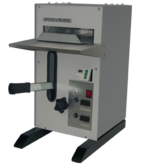
PEVP A5 Moulding and Vulcanizing Press
Moulding and vulcanizing press to press characters into a matrix board and get a mold in which rubber/ ink is molded
- Size A5 (270 x 230 mm)
- Hydraulic pressure provided by coupled hydraulic jack and pump
- 2 PID electronic controllers securing perfect accuracy and distribution of temperature for pre-inked and rubber stamp making
- Manual digital timer for control of processing times.
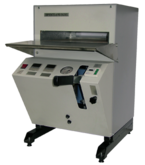
PEVP A4 Moulding and Vulcanizing Press
Moulding and vulcanizing press to press characters into a matrix board and get a mold in which rubber/ ink is molded
- Size A4 (350 x 300 mm)
- pressure is provided by separate pump and jack
- 2 PID electronic controllers secure perfect accuracy and distribution of temperature for pre-inked and rubber stamp making
- Manual digital timer for cycle control
- Manometer for pressure control
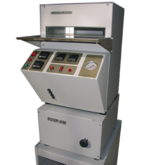
Automatic Moulding and Vulcanizing Press
Motorized moulding and vulcanizing press, size 350 x 300 mm, for rubber and pre-inked stamp making.
All manufacturing steps are automatically performed . It is just necessary to set parameters (temperatures, preheating and cooking times, cooking pressure) Then, pushing a single key will automatically start the procedure : platen rising, contact during pre-heating time, degassing, pressure and cooking , opening when programmed time is over.
- Pressure by motorized hydraulic pump, with separate jack to avoid heat transmission to hydraulic parts.
- automatic control of manufacturing cycles
- preheating and curing time are controlled by a digital timer
- switch for additional degassing
- emergency stop
- manometer for pressure control
- 2 PID electronic controllers securing perfect accuracy and distribution of temperature for pre-inked and rubber stamp making
Applications
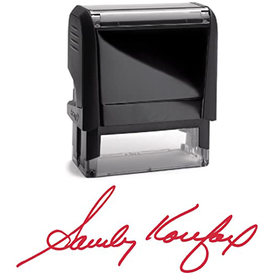
Anything can be reproduced on a rubber stamp : logo, photo, signature
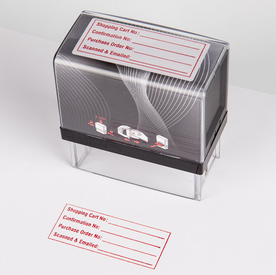
Automatic mount with rubber stamp : simple marking for documents.
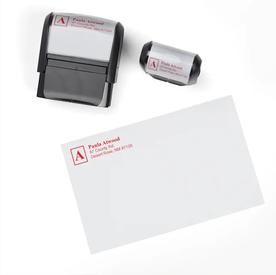
Automatic rubber stamp for administrative document marking
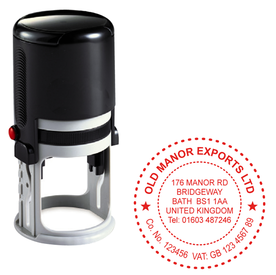
Automatic stamp : rubber stamp in a a self-inked mount
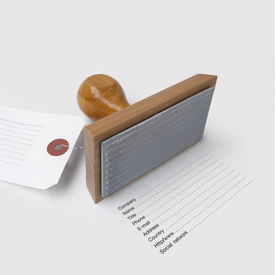
Rubber stamp for fast reproduction of information : tables, references ...

Rubber stamp : guarantee for quality reproduction and inking

Clear company identification with rubber stamp on wooden handle
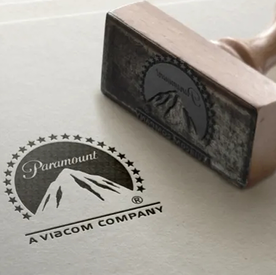
Commercial rubber stamp : logo, visual identity, slogan, ... everything can be reproduced

Company rubber stamp on a plastic mount
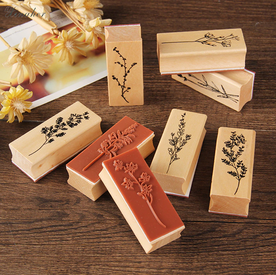
Creative hobbies, scrapbooking, art stamps ... activities where using rubber stamps is essential
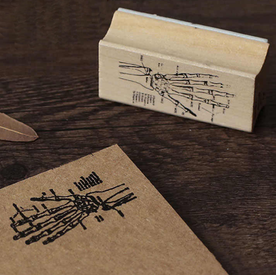
Art stamp for scrapbooking : decorate, create, imagine products at your image

Art stamps for scrapbooking : announcements, birthdays, decoration ...
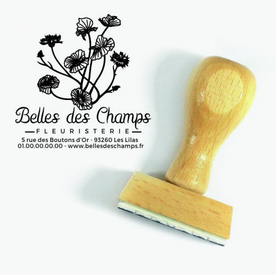
Decorative stamp on wooden handle for scrapbooking

Scrapbooking with rubber stamp : announcement, menu, greeting card, postcard ...
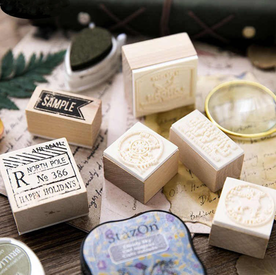
Scrapbooking rubber stamp on wooden mount : decorations, cards, congratulations cards, ...

Rubber stamp for scrapbooking : card making, decoration, creative activities..
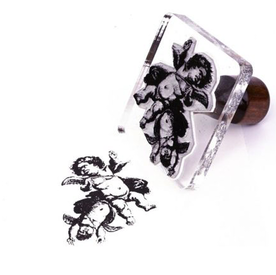
Scrapbooking stamp on transparent mount for better visibility
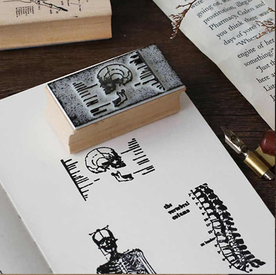
Educational rubber stamp : for easier and funnier learning in education applications

Pocket rubber stamp to take everywhere you go.

Company stamp for identification of document , confirmation of delivery...
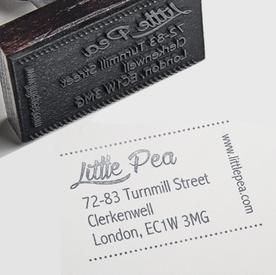
Company stamp : address, web site, bank information...

Personalization of document , humorous message... with a rubber stamp.

Customization of packages, labels, products... with a rubber stamp
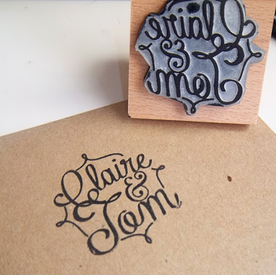
Scrapbooking stamp in blue rubber (several colors available)

Stamp with company contact information , important message, slogan...
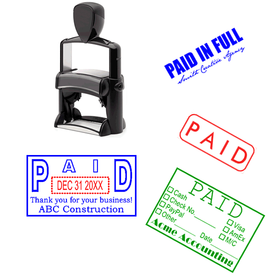
date, personalized formula with rubber stamp on automatic mount
Videos
Faq
A (rubber) stamp is meant for marking on various supports.
It is mainly used to print information on administrative documents (validate a document with company stamp, obliterate a mail, date a document..) or artistic creations (greeting card or announcement decorations, labels..)
It is made of :
=> An inked pad
=> A rubber or polymer layer containing pattern
=> A mount / handle
Ink can be adapted according to application : there are acid inks for engraving, inks for textile, for metals, for outdoor uses…
Rubber stamps are mainly used for administrative applications, as a signature of a company, administration, commercial entity or individual. However other kind of stamps are available, such as daters specifically used to date documents or numberers to affix numbers on document series.
In France, company stamp is required to process most documents such as contracts, quotes or delivery notes. Signature is generally made next to or on the company stamp, with date.
Stamp is also widely used in scrapbooking applications, to customize creations : cards, announcements, albums, Christmas cards, birthdays… Multiple accessories are available for using rubber stamps in a different way : embossing powder, multi-color ink, metallic inks ...
Finally, stamps are also used in specific applications: outdoor use with UV inks, tracking information (for instance ampoules, with acid inks), textile marking for clothes…
Historically, texts were arranged and images were engraved by typographic workers then gathered together and tightened inside a forme. Then a matrix made of wax and other materials was placed on top and the whole was placed inside a heating press to imprim patterns inside softened wax.
After cooling, the wax mold was covered with rubber and parchment paper and placed again in the heating press so that rubber can flow inside mold depth and produce relief for stamps. The resulting rubber sheet was cut into stamps.
Development of computers allowed to give up cumbersome manufacturing tools (lead character fonts, presses..) and use computer-aided publication and photosensitive polymers
Now, stamp manufacturing process consists of several easy steps:
- patterns to be reproduced are drawn on a computer
- a film is printed to get a negative
- photopolymer liquid resin is exposed through the negative to get a photopolymer stamp, or hard photopolymer plate is exposed to produce a cliche
- photopolymer cliche is pressed into a matrix board to get a mold for rubber (rubber stamps) or premix gel (pre inked stamps) moulding
« stamp » word can include inking pad, box containing ink pad, instrument used to transfer a print on a document and even final print. Stamp can be manual or automatic.
Our company offers products for the “seal” technical part of the stamp : part in rubber, photopolymer or pre inked material with characters, logo or drawing to print.
In case of rubber or photopolymer resin, stamp surface should be coated with ink from an ink pad. Then, stamp is placed above support and pressure is applied to transfer ink from stamp surface to the support. For another print, it is necessary to ink again stamp surface.
In case of pre-inked material, ink is directly contained in the microporous structure of the stamp (ink capsules).
Production of conventional or laser rubber stamps requires no special layout. Working space should be large enough for accomodation of necessary equipment and include some space for assembling stamps to mounts and for storing devices.
Some odor may be released during production, room must be well ventilated or, for more comfort, equipped with a controlled mechanical ventilation.
To produce stamps for scrapbooking , the same pattern should be molded several times to get several copies of the same stamp : each model is ordered several times by several customers.
In conventional rubber stamp manufacture, a photopolymer plate (with patterns in relief) is pressed into a matrix board, in a heating press,to produce a mold (with patterns in depth). Rubber is pressed in the resulting mold to produce final stamp.
Once the mold with patterns in depth is obtained, it can be stored and re-used according to request : it is possible to mold again a single stamp or a complete plate with only rubber as raw material.
So conventional rubber stamp is the fastest and cheapest technique,
Other techniques requiring to redo all processing steps, they are not so interesting for scrapbooking.
Two techniques are possible, with two different equipment
Laser engraved rubber stamps
It is necessary to have a laser engraver : see our Eko or industry laser ranges.
The higher the power chosen,the faster stamps will be engraved.
For more information, see Engraving / Co2 laser section.
Conventional rubber stamps (matrix board)
It is necessary to have
- a laser or inkjet printer to print a film
- a photopolymer machine to expose and process photopolymer plates, and get a cliche with patterns in relief
- a vulcanizing press (3 models available) to press the photopopolymer plate into a matrix board and get a mold (patterns in hollow), then to press rubber into the mold.
In case of rubber stamps, two manufacturing solutions are possible : laser engraved rubber or rubber molded in a matrix board. These two techniques are to be compared to photopolymer resin technique
Photopolymer liquid advantages
- faster processing (25 -30 minutes).
- a single small sized machine necessary
- very low equipment depreciation therefore low stamp cost price
Photopolymer liquid drawbacks
- ink restitution not so good (polymer closed structure)
- resistance not so good over time
- resistance to alcohol-based inks not so good
Laser/conventional rubber advantages
- better resistance to inks (especially alcohol-based ones).
- more resistant over time
- better ink restitution (rubber por
- choice of colors, nobler material.
Laser engraved rubber advantages
- Fast processing (3 minutes 30 s) for a single stamp with a laser engraver
Conventional rubber advantages
- lower equipment cost, compared to laser
- Cost for additional copies of a same stamp is very low and processing very fast : once the mold (with patterns in hollow) is obtained, only rubber is necessary and fast vulcanized.
Laser engraved rubber drawbacks
- high investment cost (laser engraver)
- long engraving time (2 hours 40 for A4 size, including 40 stamps, with a 30 w machine) that can be reduced using a higher power laser tube.
- important maintenance : 90 % of rubber material need to be removed and release a lot of dust that dirty the machine.
- same work and same cost for additional copies of a same stamp
Conventional rubber drawbacks :
- longer processing time for the first copy (1 hour 10 for a 40 stamp A4 size)
Characteristics of 3 stamp types are summarized in the table below:
As a result:
Photopolymer stamps require low investment; their production is relatively economical and fast.
Conventional rubber stamps are interesting for large volume and additional copies of a same stamp (scrapbooking for instance)
Laser speed is interesting for small quantities, larger quantities requiring significant investment (100 w power). Also, it is important not to forget laser maintenance cost.


